By Roger Grody
What’s on your bucket list? Climbing Mount Everest, playing golf with your favorite PGA pro, or cooking with a celebrity chef? These are the kinds of fantasies available for purchase at a unique online marketplace called IfOnly, which offers unique, modestly priced experiences in addition to life-changing adventures priced in the millions. Because a portion of the proceeds fund charitable causes, your real-life fantasies are actually helping others.
Founded in 2012 by tech entrepreneur Trevor Traina (currently the U.S. Ambassador to Austria), IfOnly is the kind of marketplace that could only exist through technology, but is rooted in an old-fashioned philanthropy. The platform collaborates with more than 250 nonprofits and charitable organizations, from Ronald McDonald House to the American Red Cross, Farm Aid to Share Our Strength. Adventures range from the arts (e.g. a personalized tour of the Art Institute of Chicago) to adrenaline rushes (e.g. racing a Lamborghini), and represent all price points.
IfOnly’s Vice President of Marketing & Growth Katelyn Watson reports, “We first gained traction with celebrities discovering these experiences were a great way to build a deeper connection with their fan base while supporting charities dear to them,” and notes it expanded from there. “Those interested in backstage passes to a Shania Twain concert ($2,500, supporting the singer’s own foundation) are the same people looking for something really cool to do over the weekend,” says Watson.


She cites baking macarons with a French pastry chef ($95), a private tour of a Frank Lloyd Wright landmark ($25) or getting up-close and personal with an endangered red panda at the San Francisco Zoo ($325) as affordable adventures. “Most of the experiences on IfOnly are impossible to find anywhere else, because we curate them personally with the talent or luminaries involved,” says Watson. Recently offered were exclusive World Cup watching parties — $3,250 netting chauffeur service, a pair of Pantofola d’Oro Italian leather soccer shoes and the company of British soccer legend Kevin Keegan — with donations benefitting the James Beard Foundation.
At least 5 percent of the price for an experience goes to the designated charity, but Watson reports many celebrities donate 100 percent and that the average contribution is almost 50 percent, with a small amount retained by IfOnly for administrative and marketing costs. The San Francisco-based organization is currently active in seven major U.S. markets, but expansion to hundreds of cities internationally is planned. The ability to offer experiences at travel destinations favored by their customers is envisioned as IfOnly’s natural evolution.
The concept is particularly popular with millennials, says Watson, who explains, “They’re not used to traditional means of giving and tend to focus their time and money on unique experiences,” but adds, “They also like to give something back.” IfOnly has limitless applications in the corporate world, for teambuilding adventures, employee retention and gift programs, suggests Watson.
IfOnly’s partners are pleased with their participation. “We were looking to reach potential millennial donors through new technology and digital experiences, which made IfOnly an ideal partner,” reports Maia Raposo, communications and marketing director of Waterkeeper Alliance, a nonprofit dedicated to preserving clean, drinkable water. “We’ve collaborated on social media initiatives, media outreach, and other marketing opportunities, helping us to get our brand recognized by a wide audience,” she adds.
www.ifonly.com
Olivela, a luxury merchandise platform, allows consumers to indulge their excesses while making the world a better place.
Typically, shopping at fancy designer boutiques and contributing to the welfare of the world’s most vulnerable or neglected people are at opposite ends of the spectrum of human behavior. But the website Olivela allows customers to shop for luxury fashion and beauty products, knowing that a portion of all proceeds goes to designated charities.
“Our reason for being is the good we’re able to do,” says founder and CEO Stacey Boyd, who previously founded Schoola, a second-hand clothing site that raises money for schools. “The way we were able to scale Schoola, from an initial five schools to more than 35,000 today,” was a model for Olivela, she reports. Her inspiration for the concept, however, was a visit to a refugee camp in Kenya where she met young Malala Yousafzai, who won the Nobel Peace Prize for her advocacy of education for girls and young women in developing nations. “I reached into my handbag for my cellphone to take a photo and realized that the cost of that bag could send a girl to school,” recounts Boyd.
After launching last year with 12 brands, Olivela now offers more than 200 luxury brands — iconic labels like Givenchy, Jimmy Choo, Prada, Valentino, and Burberry — and a portion of every purchase goes to one of the company’s affiliated charities. Olivela’s giving is focused on the Malala Fund, CARE and Too Young to Wed, all committed to ensuring that girls at risk of child marriage stay in school.


Boyd is pleased to see more companies asking themselves how they can contribute to urgent social causes without compromising their commercial success, and cites the example of Toms shoes, which donates a portion of profits to improve lives around the globe. “There’s an opportunity through commerce to do an amazing amount of good in the world,” says the entrepreneur, who genuinely believes in the power of giving. Olivela may, in fact, prove to be a model for a diverse range of ventures, whether Internet-based or brick-and-mortar.
Every piece of merchandise on Olivela is listed with the actual impact its purchase can affect, such as the 28 days of school funded by a $995 Ferragamo wallet. The shopper can learn which organization each purchase is funding, the nation the donations will be sent to and even the specific girl being assisted. “You’ll know, for instance, that you’re helping a 15-year-old Syrian refugee named Joury and will receive notice of her first day of school and see her report card,” explains Boyd. By allowing customers to monitor the progress of the individuals whose lives are changed by their purchases, a culture of accountability and connectivity is created.
“Educating one girl can help transform an entire village,” suggests Boyd, who insists education not only keeps young girls out of unwanted wedlock but helps them and their families overcome poverty. “When a customer is wearing a beautiful necklace she purchased from Olivela, she’ll be reminded of the impact it’s having on the life of a young girl, her family and community,” says Boyd.

Photos courtesy of Matthew Alland – Schoola
This originally appeared in Unique Homes Ultimate Issue 2018
By Camilla McLaughlin
What’s on the horizon for retail?
Everything from enhanced technology that will point customers toward stores, sales or experiences based on past behavior, to a menu of ever-evolving, engaging venues including theaters, art galleries, craft brewers and distillers, luxury motoring, spas, yoga and fitness, rooftop restaurants, farmers’ markets and concerts.
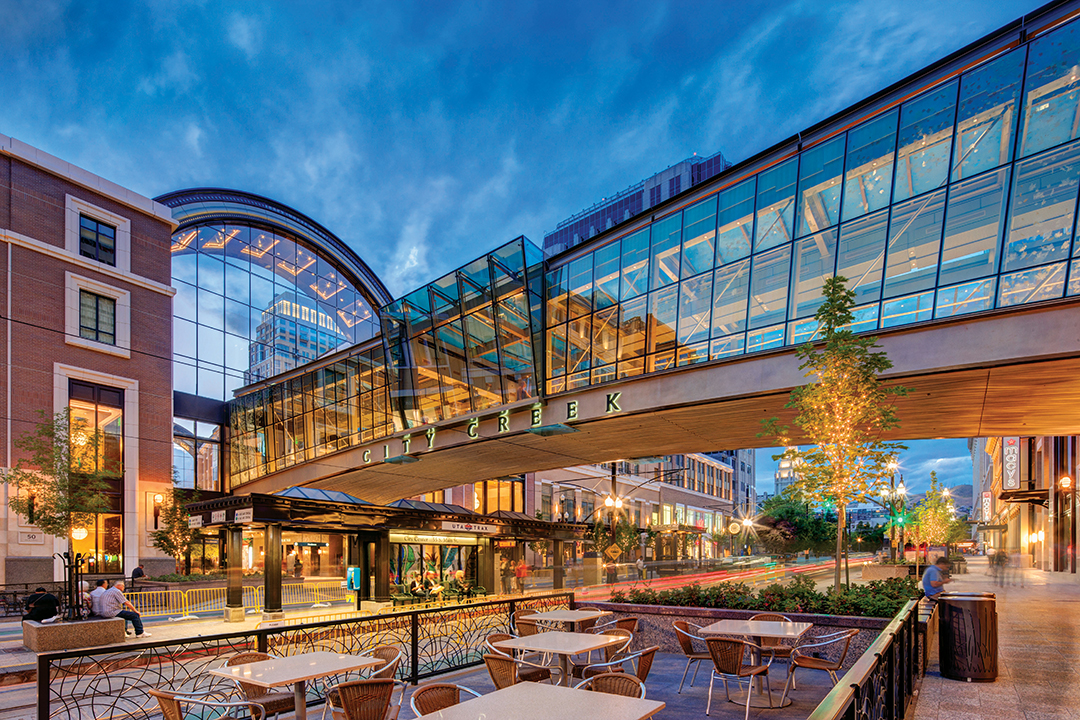
Photo courtesy of the Taubman Company LLC
In January, Macy’s released a list of 68 stores to be shuttered, a number that later grew to 100; the next day Sears announced the closing of 150 stores, a number that later swelled to 250. A month later, J.C. Penney announced plans to close 138 stores. It seemed that a “retail apocalypse” might be at hand as if one of the largest industries in the U.S. was going to suddenly disappear. But commercial developers, contractors and planners have an entirely different take on the situation. Instead of sudden death, they see a metamorphosis into something more experiential, authentic and consumer- and community-oriented.
“Headlines might make it seem every shopping center is going to be vacant, but that’s not the case. We are in a period of evolution. If you can’t adapt, you can’t evolve. The one constant in this industry is change,” said Jeff Kreshek, senior vice president West Coast Leasing, Federal Realty Investment Trust, speaking on a panel focused on retail at a recent Urban Land Institute (ULI) conference.
Even though industry observers acknowledge change and recognize the need for further change, a scenario in which brick and mortar stores will fade as the preferred outlet by consumers is unlikely, according to ULI’s 2018 retail outlook. “Retail itself is alive and well,” says Brian Andrus, president of the Florida Gulfcoast Commercial Association of Realtors. Spending might fluctuate with the economy, but the long-term average growth for retail sales is 4.18 percent, significantly higher than the U.S. GDP. The National Retail Federation’s annual consumer spending forecast expects holiday shopping in November and December to increase retail sales between 3.6 and 4 percent.
Overall, online only accounts for about 10 to 11 percent of all yearly retail sales. Surprisingly, this number is equal to the amount captured by catalog and mail-order sales in 1995.
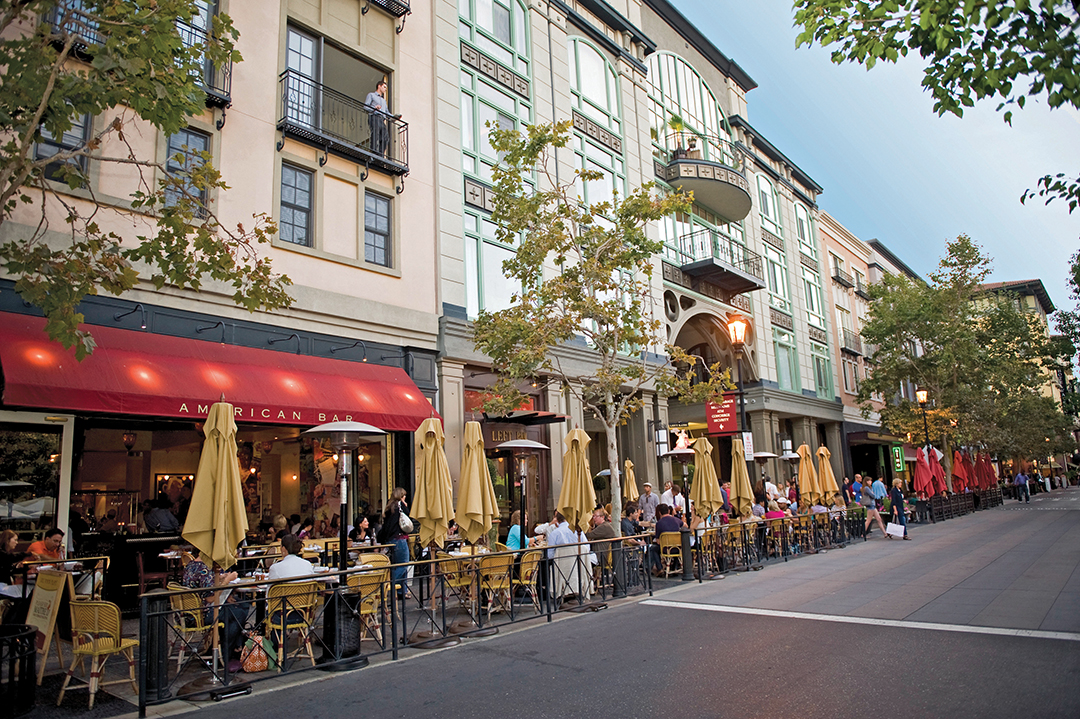
Online shopping often takes the blame for empty retail spaces, but that’s only one of several factors at play. Another is simply an overabundance of space. A study by Cowan and Company estimated the U.S. has 40 percent more shopping space per person than Canada, five times more than the U.K. and 10 times more than Germany. Expectations are that some portion of this excess capacity will be refocused. One example is The Mark 302, which is an old Sears building in Santa Monica being redeveloped by Seritage Growth Properties. Reconfigured from the inside out, the new building is infused with light. Green walls and the use of wood lend an organic feel. Half of the space is devoted to creative offices. Lower levels include small retail shops as well as a diverse food hall.
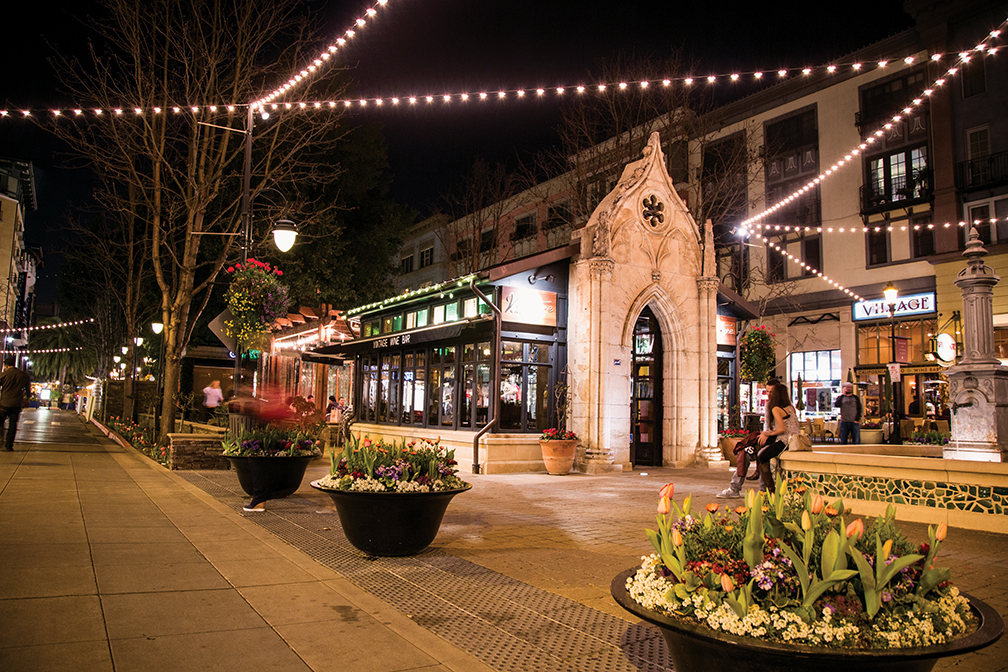
Photos courtesy of Santana Row
“You have to engage with people on a sensitive level and give people a reason to be there without being crammed down by shopping. It’s not the shopping, but the experience,” explained Kreshek, using the example of Santana Row in San Jose.
Demographics and shifting consumer priorities require retailers to give consumers a reason to go to a mall. “You have to engage with people on a sensitive level and give people a reason to be there without being crammed down by shopping. It’s not the shopping, but the experience,” explained Kreshek, using the example of Santana Row in San Jose.
“Malls are dying, but not all of them. The demise of the department store contributed to that. Retail is changing, but it’s not broken, it’s not dead. We’re seeing a lot of new projects coming out,” said Steven Siegel, executive vice president, Sagamore Development Company. Increasingly, he says, new retail entails meeting the consumers where they are and being responsive to their needs, a challenge he expects technology to augment.
New projects are likely to extend beyond the traditional concept of a mall as a separate contained entity. Rather, they are connected to the community and often incorporate a carefully calculated mix of spaces, including residential and office, as well as places for community gatherings and events.
Meeting Consumers on Their Terms
Look for omnichannel, which refers to a seamless shopping experience across multiple outlets, to be retail’s buzzword of the year, as Amazon and others explore ways to integrate multiple modes of purchasing and delivery. Amazon has moved away from pure-play distribution, opening pick-up centers near college campuses as well as actual bookstores in Boston, San Diego, Portland, San Jose and Seattle. Savvy companies from Nordstrom to Walmart to Chico’s already sync online with bricks and mortar, so one enhances the other. A strong online component also augments in-store inventories.
For luxury, omnichannel is expected to be a top 2018 trend, according to the Luxury Client Experience Board and the Luxury Institute. Milton Pedraza, CEO of Luxury Institute explains: “There is a digital transformation that’s required across all channels as companies realize that the consumer experience is non-linear. They may research products in one place,obtain pricing information at another, and then choose to make the final purchase either in-store or online.
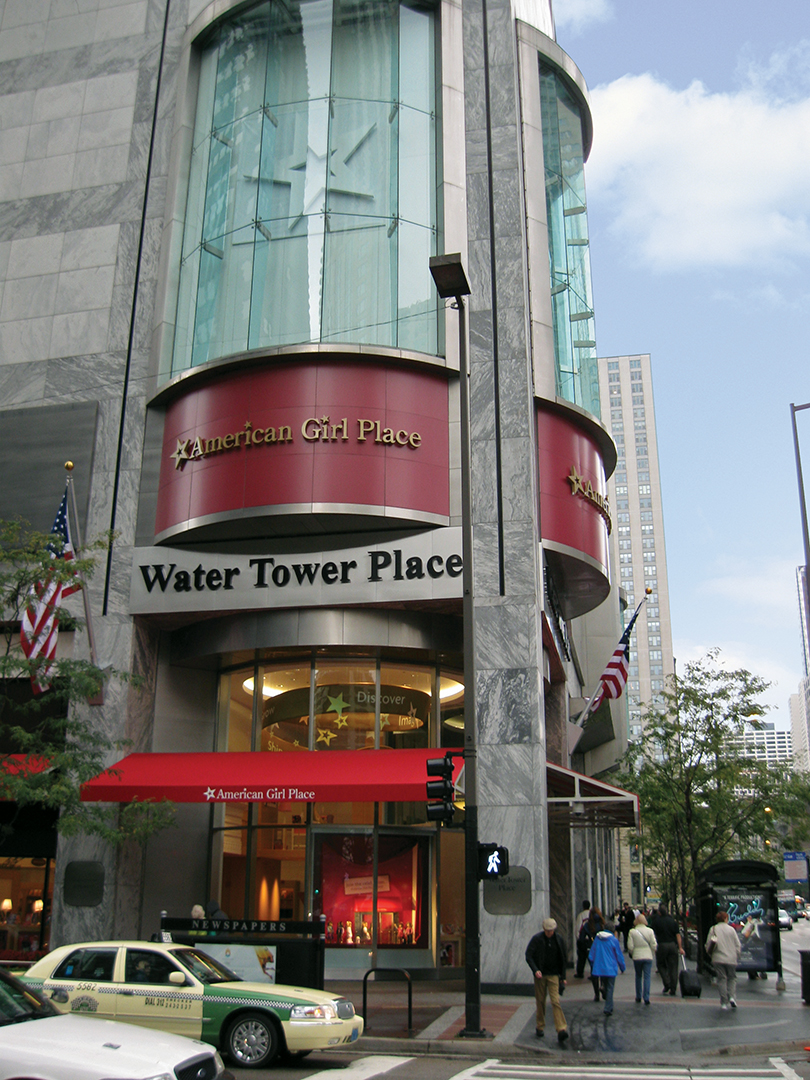
“They may purchase online, and bring returns to the store. A seamless channel goes beyond having access to products either in-store or online. Consumers should be able to transact in any way they choose via any channel that the brand offers, and 2018 is a critical year for this objective to be met.”
Chuck Taylor, director of operations for Englewood Construction and Management in Chicago, says the move from online to bricks and mortar also reflects a growing recognition among online brands that “the one thing missing from the shopping experience is the experience itself.”
The hottest retail outlets today, according to Taylor, incorporate an experience. To illustrate, he points to an Englewood project — American Girl Place, the brand’s flagship store, in Chicago. Here shoppers can immerse themselves in the brand experience that includes creating one-of-a-kind outfits, a salon visit with expert in doll hairstyles, even doll pampering and spa treatments.
While innovative retailers are important to attracting visitors to a mall, a number of other factors ranging from authenticity to local flavor to the physical setup and a carefully curated mix are equally essential. Wellness is also growing as a mall addition, and these features offer a way to engage with consumers who increasingly want to do something important with their lives.
Taylor also sees a growing presence of high-end automotive brands like Tesla and motorcycle manufacturers, whether as pop-up shops or full-on sales galleries. “These luxury motor brands are being considered by developers as unique and creative additions to their tenant mix,” he says.
Outward Orientation
Traditional malls were typically inward focused; new power malls connect with the outside with light-filled atriums, green walls and water features enhanced by well thought out connections between retail outlets, restaurants, other experiences, parking and the outside. Many, both open and enclosed, are organized around the concept of a main street, whether this entails turning several streets into an iconic shopping district or creating one in an entirely new setting.
Built during the recession, City Creek Center in Salt Lake City (pictured at top and below) covers several city blocks. A retractable roof turns the enclosed space into an open-air venue. A creek runs along the main walkway, and there are multiple entrances from adjacent streets. Like many new malls, this project includes a mix of residential and office space with local and national retailers.
“The appeal of the surrounding shopping center or village is rivaling the importance of the individual store in attracting traffic drawn to a retail destination for the quality of the overall experience. The entire shopping center, or the mall, has to create a great experience, and those on the leading edge of luxury offer shoppers spas, art exhibitions, music and other entertainment to enhance the shopping experience,” says Pedraza.
Already, landlords and developers are drawing on local communities to provide input into new retail developments, and the local synergy lends more authenticity.
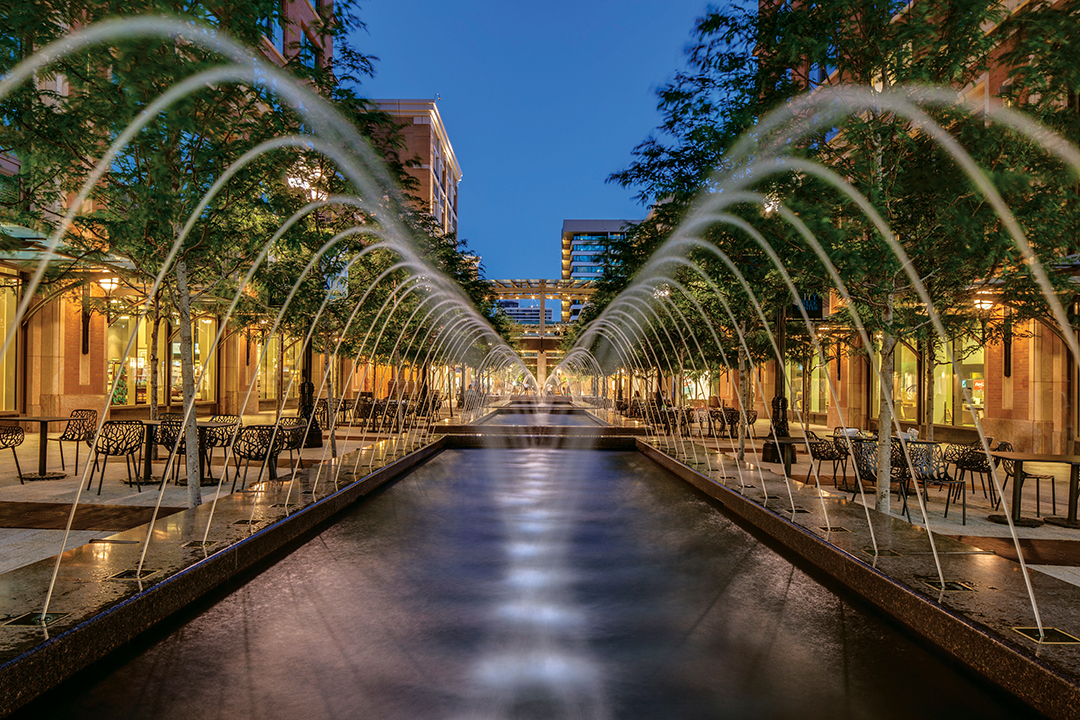
Photo courtesy of the Taubman Company LLC
Big Box Business
The discount sector continues to resonate with consumers with Ultra, T.J. Maxx and Dollar General opening new stores. Big Box retailers such as Target are also experimenting with new formats and smaller spaces.
“Landlords and developers are finding they have to be creative in what they do with a space,” says Taylor regarding renovations and repurposing. Suggestions for large spaces from shuttered stores include a theater, night club or rock-climbing spaces. Another consideration for a shuttered store, part of an existing mall, was to demo the building and create a large outdoor gathering space. Outdoor or indoor spaces for everything from concerts to farmers’ markets are becoming a mall essential.
Restaurants continue to be a focus for landlords and developers, and many see food along with local breweries and craft distillers as a magic bullet. Food and a connection to the local community are central to the revitalized Packing District in downtown Anaheim, which turned a former citrus packing facility and Packard showroom into a food-oriented venue that includes a food hall, a large central atrium surrounded by café and kiosks for communal dining, an outdoor garden and a long outdoor porch for dining.
“It’s not about the food, but more about the community and what these spaces do for the neighborhood and bringing people together,” shared Chris Bennett, director of development for LAB Holding.
For most retail spaces, food is only one element in a successful mix. “Good food is really important, but it is not the panacea,” adds Kreshek. Still, food, wellness and fun events might be the secret sauce that will convert more e-commerce entities to bricks and mortar. And overall, look for the new retail to increasingly become a place for community connections.















